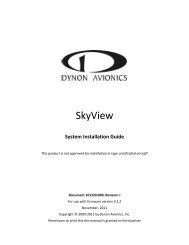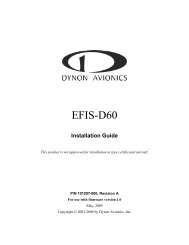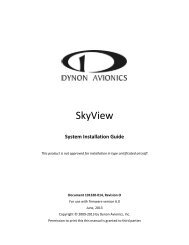EFIS-D100 Installation Guide - Dynon Avionics
EFIS-D100 Installation Guide - Dynon Avionics
EFIS-D100 Installation Guide - Dynon Avionics
Create successful ePaper yourself
Turn your PDF publications into a flip-book with our unique Google optimized e-Paper software.
Autopilot <strong>Installation</strong> and Configuration<br />
the servo can exert, arm travel, control surface resolution, and the amount of force required to<br />
shear the brass shear screw. The two inner-most holes of the servo arm should only be used if the<br />
installer fully understands the resulting implications. The diagrams above illustrate the linear<br />
travel and available force for each mount point on the standard and long-arm servos.<br />
CAUTION: Each <strong>Dynon</strong> <strong>Avionics</strong> servo includes a precision-machined brass “shear<br />
screw” that pins the servo arm to the servo arm attachment, providing an ultimate<br />
“manual override”. The shear screw will break at the application of 100 inch-pounds of<br />
torque, at which point the servo arm will travel freely. If the brass shear screw is broken<br />
during AP installation or usage, do not replace it with a standard screw - contact <strong>Dynon</strong><br />
for a replacement shear screw.<br />
There will be a variety of methods used to install the other end of this control linkage to the<br />
existing mechanicals of the aircraft. Some systems will use a hole drilled into the bell crank as<br />
the point where the servo push rod/rod end combination interfaces with the controls. Others will<br />
use an attachment to existing linkage. Others may attach directly to the control stick itself. It is<br />
up to the installer to decide which method is best in terms of safety and AP functionality.<br />
Installers should always keep in mind the range of motion of the servo. Total servo arm travel<br />
needs to be limited to prevent an OVER CENTER condition (see caution note above), while still<br />
preserving the control surfaces’ full range of motion. Carefully consider the prevention of an<br />
over center condition when selecting the mounting location and linkage attachment point for any<br />
servo installation. The built-in control stops of the aircraft will limit the servo arm travel when<br />
installed correctly. Again, <strong>Dynon</strong> strongly recommends that the included Range of Motion<br />
Limiting Bracket be installed in order to absolutely prevent the possibility of an over center<br />
condition. The Range of Motion Limiting Bracket should not be used as a normal stop; the<br />
aircraft’s built-in stops should always be the primary range limit.<br />
6-10 <strong>EFIS</strong>-<strong>D100</strong> <strong>Installation</strong> <strong>Guide</strong>
















